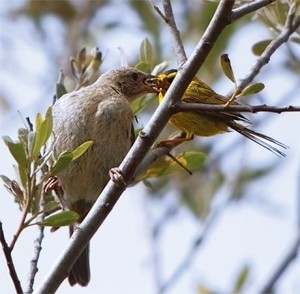Even devoted birdwatchers find it tough to love the brown-headed cowbird. Black body. Fat head. Grating voice. And the female is a homely gray. Not exactly a glamor couple. But appearance is only part of the cowbird’s PR problem.
What most disturbs some birders is cowbird breeding behavior, which biologists call “brood parasitism.” Cowbirds build no nests of their own. After having indiscriminate sex, females wander the landscape laying eggs in the nests of other songbirds, leaving the unwitting foster parents to raise the cowbird chicks.
This doesn’t always turn out so well for the host family. Cowbird chicks exercise brutal sibling rivalry. They tend to grow faster and larger than their adoptive siblings, gaining an edge in gobbling the food delivered by parents. During the melee at feeding time, cowbird chicks might stomp on and smother nestmates. They sometimes even push eggs or chicks out of the nest.
The most poignant evidence of all this comes after the cowbird fledges. Birders occasionally encounter an elegant songbird – a northern cardinal, a chipping sparrow, or a yellow warbler, for example – feeding a hulking cowbird chick out of the nest (see photo). It’s like a human mom with triplets feeding a fourth who happens to be an NFL linebacker.
But let’s give cowbirds their due. After all, cowbirds are simply being cowbirds. Like the rest of us they’ve adapted to changes in the landscape.
We suspect that cowbirds originally ranged across the Great Plains, where they fed on insects kicked up by herds of bison or other ungulates grazing on native prairie grasses. Seems like it would have been a nice life. But because their food source roamed the plains, cowbirds could not anchor their nests in a particular territory and continue to feed young. So they put their eggs up for adoption and then headed out to feed with the herd.
In the Northeast, settlers (literally) opened the landscape to cowbird immigration. By clearing forests for farms and towns, people set the table for brown-headed cowbirds, whose subsequent eastward expansion subjected our forest birds, particularly those nesting near edges, to cowbird tactics.
At least that’s the standard hypothesis. Another way to look at it would be that cowbirds have exchanged the normal risks and energy demands of reproduction – courtship, defending territory, and raising young – for the ability to produce lots of eggs; a female cowbird might lay dozens of eggs during the breeding season, a feat accomplished by few other birds.
Cowbirds are reported to have parasitized more than 220 bird species, with yellow warbler, song sparrow, red-eyed vireo, chipping sparrow, eastern phoebe, and red-winged blackbird among the most common victims. Their brood parasitism presents particular risks to certain bird populations, notably the rare Kirtland’s warbler, which nests in jack pine stands, mostly in Michigan. Cowbirds have been trapped and removed from breeding grounds as part of the Kirtland’s recovery plan.
But other species do battle with cowbirds. American robins, gray catbirds, and northern orioles, for example, sometimes recognize cowbird eggs and push them out of their nests. Redwinged blackbirds and clay-colored sparrows are known to abandon their nests upon finding a cowbird egg.
Yellow warblers, probably unable to remove a cowbird egg, employ another strategy: avian condominiums. If she encounters a cowbird egg in her nest, a yellow warbler might choose to cut her losses by building a new nest on top of the old one. She may be more likely to add another layer if the cowbird beats her to the drop with the nest’s first egg, and less likely to do so when more of her own eggs are in the nest.
A yellow warbler might stack her nests five or six high, although two or three stories is more common. In any event, it’s a rare example of how rampant housing development can help a songbird survive.



Discussion *